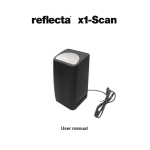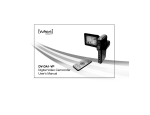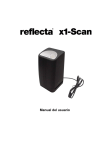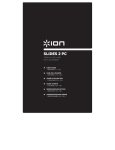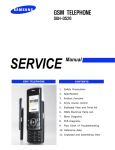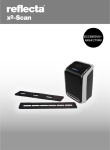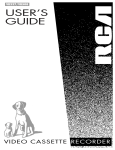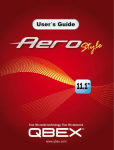Download Manual - VuPoint Solutions
Transcript
For customers in North and South America 0B For customers in USA This device complies with Part 15 of the FCC rules. Operation is subject to the following two conditions: (1) This device may not cause harmful interference. (2) This device must accept any interference received, including interference that may cause undesired operation. For customers in Canada This Class B digital apparatus meets all requirements of the Canadian Interference-Causing Equipment Regulations. For customers in Europe 1B “CE” mark indicates that this product complies with the European requirements for safety, health, environment and customer protection. “CE” mark cameras are intended for sales in Europe. -1- 1. Name of parts ______Cleaning brush Note: This film converter supports Windows XP SP2 and Vista via USB 2.0 only. We strongly suggest using a clean, dry, non-alcohol cotton swab or the cleaning brush that is included with your unit to insert into the film scanner slot and clean the surface periodically to produce a clear image. Please make sure your film negatives/mounted slides and trays are clean before inserting into the converter as well. Dust or dirt from the negatives and cover trays will affect the quality of your converted images. -2- Cleaning the dust from the film scanner lens: 2B Open the PhotoImpression 6 software as if you were about to convert a picture. Do not insert any slides or negatives into the film converter slot. You will be able to see the dust that is on the lens from the PhotoImpression 6 live view window. (See the example shown below, the dust is circled.) Then you can use the cleaning brush to wipe the dust. We strongly suggest using a clean, dry, non-alcohol cotton swab or the cleaning brush that is included with your unit to insert into the film scanner slot and clean the glass surface periodically to produce a clear image. -3- 2. How to install slides and film into the tray holder a. Open the tray as illustrated b. Put a slide in the film slot as shown. Note: Do not flip slides, if flipped, the images will be converted backwards. c. Close the tray holder. Note: Please use the negative film holder and follow steps a-c to install film negatives. -4- 3. Installing the software and driver To use the film converter you must install the film converter driver and ArcSoft PhotoImpression 6 in advance. • Installing the driver. 1. Turn on the computer. 2. Insert the installation CD into the CD-ROM drive and the installation CD menu will appear. 3. When you see the following screen, choose “Scanner Driver”. Windows XP directions: → 3.1. Click Next to start the installation process. 3.2. Click Install. -5- 3.3. Installation process will begin. 3.4. Once installation is complete. Click Finish. Windows Vista directions: → → 3.1. Click Next to start the installation process. -6- 3.2. Click Install. 3.3. Installation process will begin. 3.4. Once installation is complete. Click Finish. 3.5. Take out the installation disk and restart the computer. • Installing the software 1. Insert the installation CD into the CD-ROM drive and the installation CD menu should appear. 2. When you see the following screen, choose “Arcsoft Software Suite” to install the software. -7- Windows XP and Windows Vista directions: 1. Select the language you wish to be 2. PhotoImpression will start the installation. displayed. Then click OK. 3. Click on Yes to agree to the terms and 4. Click Next to have PhotoImpressions conditions. download into your Programs folder. -8- 5. Click Next to continue. 6. PhotoImpressions will start the setup process. 7. Once you get this to this screen select 8. Click on Finish to complete and restart the "Clear All" so that PhotoImpressions does computer. not take over the files on your computer. 9. The installed software will automatically create a “PhotoImpression 6” logo on yourdesktop. Restart the computer and remove the installation disk. Note: If a “Code 10 error” appears on your screen when using the program, please do not unplug your device from the USB port of your computer. Please restart your computer and resume running the PhotoImpression program. -9- 4. Connecting the film converter to your computer with the USB cable Note: Please remove the slide or film tray before connecting the device to the computer. Once connected, the power LED light will be red. Please follow the steps below to synch up the hardware with the software on the computer using the Found New Hardware Wizard. Note: The Found New Hardware Wizard will only come up if the film converter is connected to a 2.0 USB port. Windows XP directions: 1. Connect the film converter to the computer using a 2.0 USB port. 2. Do not insert the disk in to the drive and click Next. 3. Select “Install automatically” and click Next. 4. The found New Hardware Wizard will 5. Once the hardware is successfully automatically look for installed software. Installed, click Finish. -10- Windows Vista directions: 1. Connect the film converter to the computer using a 2.0 USB port. 2. Do not insert the disk in to the drive and click Next. 3. The Found New Hardware Wizard will automatically look for installed software. 4. Once the hardware is successfully installed click Close. -11- 5. Using the slide and film converter 1. Click on the “PhotoImpression 6” icon on the desktop. Follow the instructions to open the software. Pic1 Pic2 ○1 Select the location to save the pictures. A E A Note: Try to use the calibrate function before each use. This helps the light in the converter adjust. Make sure there is nothing in the converter during this process. -12- Pic3 (For first time users the converter will automatically calibrate.) Pic4 You can adjust the location of the film by moving the film. Pic5 Click snap shot on the screen or press the copy button on the film scanner. A green frame will indicate the selected picture(s) in the preview area, the maximum is 12 pictures in the preview area. If there are more than 12 pictures scanned, the 13th picture will overwrite the 1st picture. If you want to save one or more pictures, press the shift key to continue selecting pictures or the CTRL key to select a single picture. Then press the transfer button to transfer or save selected pictures to your computer. Note: To ensure the best image quality, please allow about 5 seconds between snapshots and transfers for white balance enhancement. -13- Note: Please do not minimize the window of converting screen after transferring the pictures. If you want to see the scanned pictures, click EXIT/x and you will see the picture you scanned before. (Example as below) 6. Now you can start to edit the picture as you like First, click on the picture to select, then use the Arcsoft tools to edit the pictures. - Main Menu The Main Menu appears in the upper left corner of the workspace. Many of the program's key options and controls are available in the Main Menu. To learn more about a particular menu -14- item and the options and controls it contains, choose from the list below: * File Scan for Media Files Launches the Scan for Media Files dialog box which enables you to convert your computer for all photos, music and video files. This process creates a media library that helps the program perform as fast as possible. You can scan your computer in one of the following three ways: • • • * Scan Primary Folders Only - Scans folders most commonly used for storing media, such as My Documents, My Pictures and Desktop. Scan All Folders - Scans your entire computer for media (except Windows and Program Files folders). Select the folders you want to scan - Allows you to choose the folders for scanning. View Full Screen/Play (F4) Plays or displays the first selected file in full screen view. -15- - Main Buttons * Get Photos Acquire from Scanner Here you can: • • acquire images from connected TWAIN compliant devices such as scanners and some digital cameras. assign names to image files as they are acquired (using today's date or a descriptive word). How to acquire images from a TWAIN compliant device: 1. 2. 3. 4. 5. 6. * Select a scanner or other TWAIN device from the drop down list. Choose the file format you want to use for the acquired images (JPG, BMP, TIF, PCX, TGA). If you've selected JPG as the file format, select the image quality for the acquired images (Highest, High, Normal, Low). The lower the quality selected, the higher the level of compression applied. Choose a destination folder for the photos by clicking "Browse" (folder icon) and navigating to the folder. Choose a naming method (today's date or description). Enter a description if applicable. Click "Acquire". Edit Photo Editing Tools The Photo Editing Tools module includes a complete set of photo enhancement, editing and -16- retouching controls. The window can be stretched to provide a large size view of the active photo. Double click the module's tool bar to maximize the window to fill the computer screen. In addition to the large photo workspace, the Photo Editing Tools module includes five distinct sets of controls: Enhance The Enhance feature includes two types of controls: Auto Enhance Click the "Auto Enhance" button to improve the overall quality of your pictures with a single click. Manual Fix For precise image enhancement control, adjust the brightness, contrast and sharpen sliders. How to enhance a photo manually: 1. Move the sliders to adjust the level of brightness and contrast and to make the image sharper. 2. Use the zoom slider to get a closer look at how the adjustment affects the photo. 3. Click "Apply" if you like the result. Click "Cancel" if you do not. Color This feature is designed to fix digital photos that have unnatural color or appear too dark. It's also great for fixing scanned versions of old prints that have faded or whose colors have -17- changed after many years. How to fix the color of a photo: 1. 2. 3. Drag the color balance sliders to make the photo color appear more natural. Add red or yellow to make the photo warmer. Add blue or green to make the photo cooler. Drag the Lighter/Darker slider to the left to reveal details hidden in a dark photo or to the right to make a faded photo look new again. Click "Apply" if you like the result. Click "Cancel" if you do not. Red-Eye This feature makes it easy for you to fix a red eye - a common problem in flash photography. There are two ways to fix redeye: Auto Fix 1. Simply click the "Fix Red-Eye" button to automatically find and fix all red-eye. 2. If not all of the red eye is fixed, use the "Click to Fix" method. Manual Fix 1. Use the zoom slider on the toolbar to zoom in on the photo. 2. Drag the small white box inside the zoom navigator to move over a red eye. 3. Place your cursor directly over the red eye and click. -18- 4. Repeat the process until all the red eyes are fixed. 5. Click "Undo" if you make a mistake or don't like the result. Crop This feature enables you to trim photos for a dramatic effect or cut off the distracting parts of a picture. How to use the crop function: 1. 2. 3. 4. 5. 6. Choose the crop orientation (portrait or landscape). Select a fixed proportion for the crop rectangle (4:6, 5:7, 8:10) or choose "Custom" if you want to use a different proportion. Resize the crop rectangle by clicking and dragging the red lines. Move the crop rectangle into position by clicking and dragging inside the red box. Click "Crop". The area inside the rectangle will be kept, the area outside will be trimmed away. Click "Undo" if you make a mistake or don't like the result. Straighten This feature enables you to fix photos that appear to be tilted. How to use Straighten: 1. 2. 3. Move the slider (or click the rotate buttons) until the photo appears straight. Use the superimposed grid lines for vertical and horizontal reference. Click "Apply" if you like the result. Click "Cancel" if you do not. -19- Blur Background This feature can be used in a subtle way -- to tone down un-important background details, or for dramatic effect -- by making the main subject of a photo “pop out” of the picture. How to use the Blur Background function: 1. 2. 3. 4. With your cursor, trace a line around the person or object you want to stand out. When you release the mouse button, the area outside the traced line will become slightly blurred. Drag the first slider to make the transition between the blurred and non-blurred area sharp or smooth. Drag the second slider to increase or decrease the amount of blur. Click "Apply" if you like the result. Click "Cancel" if you do not. Saving Your Results When you're done editing a photo, click Save As to save your results. You can choose to overwrite the original file or save a new one. Click "Close" to exit the Photo Editing Module. Retouch 6B Healing Brush The Healing Brush is good for fixing dust, scratches and removing skin blemishes. How to use the Healing Brush to fix a skin blemish: 1. 2. 3. Establish a source point for the Healing Brush by holding the Shift key and clicking on an area of the skin that is close in color and texture to the area you want to heal. Use the zoom control to zoom in on the blemish. Adjust the size of the healing brush so the cursor (circle) is only slightly larger than the blemish. -20- 4. Paint over the blemish. The area will be concealed. Click "Undo" if you make a mistake or don't like the result. Clone The Clone tool is good for removing unwanted elements from a photo. It can also be used for a fun effect, like moving a nose from one person to another. How to use the Clone tool to remove a telephone pole from the background of a photo: 1. 2. 3. Establish a source point for the Clone tool by holding the Shift key and clicking on an area of the sky that you want to use to paint over the telephone pole. Adjust the brush size so the cursor (circle) is only slightly larger than the widest part of the telephone pole. Click and hold your mouse button and carefully paint over the telephone pole. Do not release the mouse button until the job is done. The sky will be cloned into place. Click "Undo" if you make a mistake or don't like the result. Lighten/Darken The Lighten/Darken tool is good for adjusting specific areas of a photo. Smudge Simulate the smearing of wet paint. Please click and drag the sliders below to change the brush size and sharpness. Sharpen Sharpen blurry areas. Click and drag the sliders below to change the brush size and transparency. -21- Blur Smooth out rough areas. Click and drag the sliders below to change the brush size and intensity. Paint Brush Allows you to "paint" on your image when you click and drag the mouse. Click and drag the sliders below to change the brush size and transparency. Line Draw a straight line in the photo. Click and drag the sliders below to change the line width and transparency. Eraser Simulate an eraser, removing the image painting by paintbrush and line tools from your photo. Click and drag the sliders below to change the eraser size and effect. Saving You Results When you're done, click "Save As" button to save your results. You can overwrite the original file or save it as a new one. Or click "Cancel" to exit without saving. Clipboard The Clipboard controls are used for selecting, copying and pasting elements from photo to photo. Rectangular Select For making rectangle shaped selections. Simply click and drag cursor over photo to create the selection. -22- Elliptical Select For making elliptical shaped selections. Simply click and drag cursor over photo to create the selection. Freehand Select For making custom shaped selections. Click and drag around an object to create a freehand selection or click, click, click around an object to make a straight-edge selection. Double-click to complete the selection. Magic Wand For making fast selections based on color similarity. Simply click on a color to create the selection. Use "Add" mode and click again to add to the selection. Magnetic Select Unlike the other selection tools, Magnetic Select is partly automatic. It uses the edge of an object as a guideline when making the selection. Simply click around the edge of an object allowing the magnet to help find the edge. Right-click the mouse to undo as you go if necessary. When the entire object is traced, double-click to complete the selection. Selection Modes Changing the selection mode affects the behavior of the selection tools above. • • • New - Makes a new selection each time. Add - Adds new selections to the current selection. Subtract - Subtracts new selections from the current selection. Select All Select the entire photo. -23- Inverse Reverses the current selection by selecting the opposite pixels. Select None Removes the current selection. Clipboard The clipboard area contains controls for copying and pasting selections from one photo to another. Copy to Clipboard Copies the current selection onto the clipboard so you can paste it to another photo. Paste from Clipboard Pastes the selected clipboard image onto the current photo. After the selection has been pasted, you can move, resize and rotate the selection into position. Click Apply if you like the result. Click Cancel if you do not. Blend Makes the pasted selection blend into the current photo when it is applied. Delete Removes the current selection from the clipboard. Saving You Results When you're done editing a photo, click Save As to save your results. You can choose to overwrite the original file or save a new one. Click "Close" to exit the Photo Editing Module. Note: For more detailed information, please refer to the [Help section] of the program. -24- 7. Specification Interface: USB 2.0 Image Sensor: 1/1.8” inch 5 mega CMOS sensor (5,174,400 pixels) 4B Lens: F no.= 2.0, 4 Glass elements, Half-field Angle=15° Focus Range: Exposure Control: Fixed focus 5B Automatic Color Balance: Automatic Scan high resolution 5 Mega pixels equal to 1,800 dpi (enhances to 3,600 dpi via interpolation) Data Conversion 10 bits per color channel Scan Method Single pass Light Source Back light (3 white LEDs) Power: Powered from USB port Dimensions 3.5” (L) X 6.5” (H) X 3.5” (W) Software Arcsoft PhotoImpression 6 included 7B Language English, French, German, Italian, Spanish, Traditional Chinese, 1B 8B Simplify Chinese, Japanese Operating Systems Windows XP SP2 / Windows Vista 12B 9B *512 MB of RAM or higher (recommended), 256 MB of available 10B hard disk space or higher (recommended) Actual requirements may vary based on your system configuration and the applications and features you choose to install. -25- System Requirements Required OS: Windows XP (SP2) / Windows VISTA Minimum memory (RAM): 512MB or higher (recommended) Minimum free hard driver space: 256 MB or higher (recommended) Minimum processor type: Pentium Ⅲ Minimum processor speed: 600 MHZ Required computer ports: USB 2.0 Required disk drive (CD or DVD): CD Required disk driver speed (CD or DVD): 48X Minimum video display requirements: NO Minimum sound requirements: NO Internet connection is required: NO Type of internet browser required: NO Minimum Quick Time Version: NO Windows Media Player: NO Minimum Direct X version: Direct 9.0 Other Minimum required pre-installed software: ArcSoft PhotoImpression6 Other Minimum required components: NO -26- Frequently Asked Questions: Q: How come every time I plug the converter in to the computer I get a USB not recognized message? I have all of the software loaded on the computer. A: Make sure that you are using 2.0 USB ports. To check if your computer is running on 2.0 USB ports, please follow these steps: 1. Go to Control Panel. 2. Look for System. (If you are in category view you will have to switch to classic view.) 3. Open System. 4. Look for the Hardware tab at the top of the window, click on Hardware. 5. Click on Device Manager. 6. Look for Universal Serial Bus Controllers. 7. Expand that so that you are able to see the list of all the USB ports. 8. Look for anything that says either “enhanced”, or “USB 2”. If you see any of the mentioned words, this means that your computer has a 2.0 USB port. This is most likely why you are getting the error message. If you do not have 2.0 USB ports, you would have to find out the make and model of your computer and purchase an add in card that will be compatible with your computer for USB 2.0. This should take care of the USB not recognized message. Q: I’m confused, when should I use the “Calibrate” function? A: The calibrate function is used to adjust the automatic white balance and the automatic exposure of the converter. You should calibrate right before you start scanning pictures to ensure the best white balance and exposure control. Q: When I plug the converter in to a USB port, the PWR light not light up on the converter. The USB port on my computer is working. What am I doing wrong? A: If this is happening, you may have a defective unit. There may be a short internally with the USB connection to your converter. Please contact the retailer where you purchased the scanner from and see if they can exchange it for you. Or you can email us at [email protected] to find out what we can do for you. -27- Q: Every time I turn off the computer and then turn it on it fails to boot and load. The computer just freezes up and I have to do a hard shut off of the computer by pressing the on/off button on the computer. I then have to unplug the converter and then plug the converter back in to have the computer load up completely and correctly and all the programs work fine. Why is this happening? Is there a software problem? A: This is not a software problem. Make sure that when the converter is not in use; detach it from your computer. This is because the scanner does not have an on/off button, so it is continually on while your computer is on and the converter is plugged in. This may be why the converter is freezing your computer. Make sure to unplug the converter from your computer when it is not in use. Only plug the unit in to the computer when your computer is fully booted up and you are ready to convert. For any further questions regarding your new film and slide converter, please do not hesitate to email us at [email protected]. HU UH VPS08-0513 FS-C1-VP-BX2_ENG -28-





























